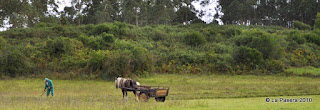The Sajambre valley lies in the Castille and Leon side of the Picos Mountains National Park. Every time we go back to my birthplace in north Palencia to visit my family, we drive on the road that takes you through the stunning Sajambra valley which lies about 1 hour´s car journey from La Pasera.
To do this 7.5 mile circular walk, we need to drive along the narrow and winding road that runs alongside the river Sella as it cuts its way though the rock to form the impresive Beyos Gorge. After 1 hour´s drive and as we leave this beautiful gorge, we drive through the villaje of Oseja de Sajambre where we can park the car and start the walk. If we follow this road, we will climb up to the mountain pass of "El Pontón" one of the three mountain passes that connect Asturias with Castille.

In Oseja de Sajambre is where the walk starts and as we follow the way marks and start walking along the very well known "archdeacon´s path" (senda del arcediano) which is a linear walk taking you deep into the Western Massif, one of the three massifs that comprise the Picos de Europa National Parrk. In time, the Archdeakon's Path takes us trough a deciduous woodland on the mountain side and gives us an opportunity to enjoy the views across the valley before reaching Soto de Sajambre, the next village on our path.
Soto de Sajambre is a village slightly off our path but well worth the extra few yards walking. I normally like to take this short detour as this small village has some very interesting architecture, we can enjoy a coffee stop while admiring the impressive surrounding scenery. Wandering along the two streets is almost like walking through a village that seems half forgotten by time and where a nice sun dial rests against a wall telling us that "time does not stop".
Retracing our steps, we soon pick up the path to the Upper and Lower Ribota villages. This stretch of the walk presents us with some of the more exciting opportunities for admiring a rich alpine flora that varies with the passage of the seasons. During late Winter and as soon as the snow melts away, the primulas, violas, hepaticas and four spices of Asturias wild daffodil are some of the alpine plants that I most enjoy.
During late Spring, there is a profusion and great variety of wild flowers producing a riot of colour. Counting number of the different types of wild orchids is one of my distractions on this leg of the path during the month of May. The sighting of all four species of Asturian wild daffodils on the same day is something that I treasure.

Lower Ribota is a good stop for lunch next to a very fast river Sella. This is a village where have been tempted to stop and sit quietly on one of those village benches where many local affairs had being discussed on days gone by and before the population of these villages started to decline in the 80's and ever since. One day while having lunch on one of those benches, we were joined by a mastiff dog carrying a big piece of stale bread in its mouth that would not eat after being treated to some of our home made bread. From the lower Ribota, the walk follows a path parallel with the river where the hedgerow is very thick and it is a good place for some bird watching. We soon start climbing up towards Oseja de Sajambre where the car awaits us passing through some very open meadows that are full of wild flowers, insects and birds; an ideal place to lie in the grass for a while and let you mind relax.

Just as we reach the end of this beautiful walk, there is an interesting farming complex turned into a small ethnographic museum that provides a glimpse into a very traditional way of farming with little dependence on solid fuel that can occasionally be seeing practised when we walk through high pasture land in early Summer.























